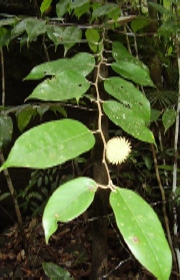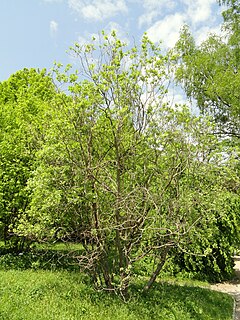
Carpinus caroliniana, the American hornbeam, is a small hardwood tree in the genus Carpinus. American hornbeam is also known as blue-beech, ironwood, musclewood and muscle beech. It is native to eastern North America, from Minnesota and southern Ontario east to Maine, and south to eastern Texas and northern Florida. It also grows in Canada. It occurs naturally in shaded areas with moist soil, particularly near the banks of streams or rivers, and is often a natural constituent understory species of the riverine and maritime forests of eastern temperate North America.

Shorea astylosa is a species of plant in the family Dipterocarpaceae. It is endemic to the Philippines, where it is known as yakal in the Filipino language.

Argyrochosma jonesii, known as Jones' false cloak fern, is a species of fern native to the southwestern United States and Sonora, Mexico. It grows on calcareous rocks, and has small, finely-divided leaves with a leathery texture and dark axes connecting the leaf segments. Unlike many members of Argyrochosma, it does not secrete white powder on the underside of its leaves. First described as a species in 1917, it was transferred to the new genus Argyrochosma in 1987, recognizing their distinctness from the "cloak ferns".

Deutzia gracilis, the slender deutzia, is a species of flowering plant in the hydrangea family Hydrangeaceae, native to Japan.

Puya mirabilis is a species of Bromeliad in the genus Puya. This species is native to Bolivia.
Kalanchoe fadeniorum is a species of Kalanchoe in the family Crassulaceae.

Salix aegyptiaca, known as the Persian willow, is a large shrub or small tree from the genus of willow (Salix) with red branches that are tomentose in the first two years and leaves up to 15 centimeters long. The natural range of the species is in the Caucasus and in western Asia. It is cultivated in many countries.
Salix anticecrenata is a low, pillow-shaped shrub from the genus of willow (Salix) with about 1.5 centimeters long leaf blades. The natural range of the species is in Nepal and China.
Salix bhutanensis is a shrub or small tree from the genus of willow (Salix) found in Nepal, Bhutan, and Tibet. It has young, densely brownish green tomentose hairy branches and 3 to 5.5 centimeters long leaf blades.
Salix chikungensis is a shrub in the willow genus Salix with tomentose hairy and later balding branches. The leaf blades have lengths of 6 to 8.5 centimeters. The natural range of the species is in China.
Salix chingiana is a small tree in the willow genus Salix with dull purple-colored, bare branches. The stipules are permanent, the leaf blades are 7 to 10 centimeters long. The natural range of the species is in China.
Salix cheilophila is a shrub or small tree from the genus of willow (Salix) with initially tomentose hairy and later balding branches. The leaf blades have lengths of 2.5 to sometimes 6 centimeters. The natural range of the species is in China.
Salix cupularis is a small shrub from the genus of the willow (Salix) with 1.5 to 2.7 centimeters long leaf blades. The natural range of the species is in China.
Salix dibapha is a shrub from the genus of willow (Salix) with mostly 4 to 6 centimeters long leaf blades. The natural range of the species is in China.
Salix dissa is a low shrub from the genus willow (Salix) with usually 1 to 3 centimeters long leaf blades. The natural range of the species is in China.
Salix divergentistyla is a shrub or tree from the genus of willow (Salix) with mostly 3 to 4.5 centimeters long leaf blades. The natural range of the species is in Tibet.
Larsenianthus careyanus is a species of the ginger family (Zingiberaceae). It occurs in Bangladesh as well as northeast India. It is the type species of the genus Larsenianthus, which was newly established in 2010.
Salix driophila is a shrub from the genus of willow (Salix). The natural range of the species is in China.
Salix erioclada is a species from the genus of willows (Salix) and grows as a shrub or small tree. The leaf blades have a length of about 5 centimeters. The natural range of the species is in China.
Salix eriostachya is a species from the genus of willows (Salix) and grows as a shrub. The leaf blades are 4 to 11 centimeters long. The natural range of the species is in India, Nepal, and China.







